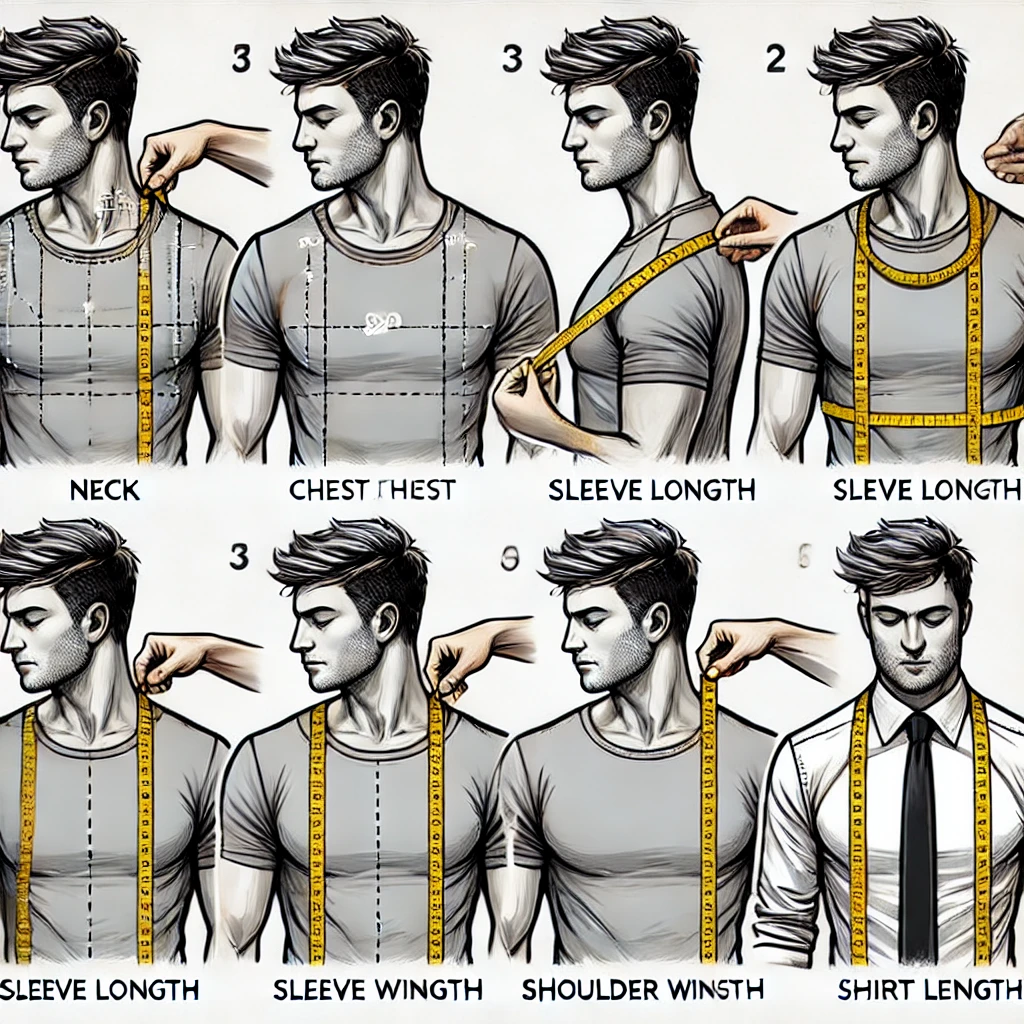How Do You Measure for Men’s Dress Shirts: A Complete Guide by LuxLineAttire
When it comes to men’s dress shirts, fit is everything. A well-fitted dress shirt enhances your appearance, provides comfort, and boosts your confidence. However, finding the perfect fit requires accurate measurements, as dress shirts are more tailored and structured than casual shirts. In this guide, LuxLineAttire will walk you through everything you need to know about measuring for men’s dress shirts, ensuring you achieve that custom, made-for-you look every time.
Why Accurate Measurements Matter for Men’s Dress Shirts
Understanding how to measure for a dress shirt is essential for a polished, professional look. Ill-fitted shirts can look sloppy or feel uncomfortable, while well-fitted shirts give off a refined and sophisticated vibe. Accurate measurements are particularly important when buying dress shirts online, as trying them on is not an option.
A dress shirt that fits perfectly provides several benefits:
- Comfort: Ensures you feel at ease, with enough room for movement.
- Enhanced Style: Gives you a neat, streamlined appearance.
- Confidence Boost: A well-fitted shirt adds to your poise and self-assurance.
Essential Measurements for Men’s Dress Shirts
To measure for a dress shirt, you’ll need to know your neck, sleeve, chest, waist, and shirt length measurements. Additionally, knowing your shoulder width and cuff size will further enhance the fit. Here’s a step-by-step guide to each measurement.
Measuring the Neck
The neck measurement is crucial, as a too-tight collar can be uncomfortable, while a loose collar can look unprofessional.
- How to Measure:
Use a flexible tape measure and wrap it around the base of your neck, where the collar would sit. Make sure the tape is snug but not too tight. For added comfort, place one finger between your neck and the tape measure. - Pro Tip: Add half an inch to the measurement to ensure the collar feels comfortable without being too loose.
Measuring the Sleeve Length
Sleeve length is one of the most critical measurements for a well-fitted dress shirt, as sleeves that are too short or long can throw off your entire look.
- How to Measure:
Start from the center back of your neck (where the neck meets the shoulder) and measure over the shoulder, down to the wrist. Bend your elbow slightly to get an accurate measurement that accounts for natural movement. - Pro Tip: Always measure both arms, as some people have slightly different arm lengths. Use the longer measurement for the best fit.
Measuring the Chest
A proper chest measurement is key for comfort, allowing enough room without feeling baggy or restricting movement.
- How to Measure:
Wrap the tape measure around the fullest part of your chest, just under your armpits. Make sure the tape is parallel to the ground and snug but not tight. - Pro Tip: Stand relaxed, and avoid puffing out your chest, as this can lead to an inaccurate measurement.
Measuring the Waist
Knowing your waist measurement is important, especially for slimmer or more fitted dress shirts.
- How to Measure:
Wrap the tape measure around your natural waistline, which is typically at or just above your belly button. Ensure the tape is snug but not squeezing your midsection. - Pro Tip: This measurement helps prevent the shirt from being too tight around your midsection, maintaining a neat, clean look when tucked in.
Measuring the Shirt Length
The length of a dress shirt affects how well it stays tucked in and looks when untucked.
- How to Measure:
Start measuring from the point where your shoulder meets your neck, down to your desired length. Typically, dress shirts are measured to hit around mid-thigh to allow for comfortable tucking. - Pro Tip: If you prefer wearing your dress shirts untucked, consider a slightly shorter length to achieve a balanced look.
Measuring the Shoulder Width
Accurate shoulder width ensures the shirt fits comfortably across your back and aligns well with your shoulders.
- How to Measure:
Measure from the edge of one shoulder to the edge of the other, across your back. The tape should be straight across without drooping. - Pro Tip: A well-fitted shoulder measurement allows for natural arm movement without pulling the fabric or creating excess folds.
Measuring the Cuff Size
While cuff size may not seem as important, it’s essential for achieving the right fit at the wrist.
- How to Measure:
Wrap the tape measure around your wrist, leaving enough room to slide a finger underneath for comfort. - Pro Tip: If you frequently wear a watch, consider adding a little extra room to accommodate it comfortably.
Additional Tips for Accurate Measurements
- Use a Soft Measuring Tape: For the best accuracy, use a soft, flexible measuring tape.
- Get a Friend’s Help: It can be challenging to take some measurements alone, so ask a friend for assistance, especially with sleeve and shoulder measurements.
- Double-Check: Always take each measurement twice to ensure accuracy, especially when ordering custom-made or high-quality dress shirts.
- Wear a Dress Shirt or Fitted Tee: For the most accurate results, wear a fitted shirt or tee while measuring, avoiding bulky clothing that may distort measurements.
How to Choose the Right Fit Based on Measurements
Dress shirts typically come in three main fits: slim fit, regular fit, and relaxed fit. Your measurements will guide you in selecting the ideal fit for your style and body type.
- Slim Fit: Designed to fit close to the body, the slim fit is ideal for men with a leaner build. If your chest and waist measurements are close, a slim fit will provide a more tailored, streamlined appearance.
- Regular Fit: The most versatile fit, providing a bit of room in the chest and waist. This fit works well for most body types and provides a classic look.
- Relaxed Fit: Offering more room in the chest, waist, and sleeves, the relaxed fit is ideal for those who prefer a looser, more comfortable fit.

Frequently Asked Questions
How often should I measure myself for dress shirts?
It’s a good idea to measure yourself every 6-12 months, especially if your weight fluctuates. Measurements may change over time, impacting the fit of your dress shirts.
Can I use the same measurements for all brands?
While measurements can serve as a general guide, sizing may vary across brands. Check each brand’s sizing guide for the best fit.
Should I measure over a t-shirt or bare skin?
It’s best to measure over a light t-shirt or a dress shirt that fits well. Avoid measuring over thick layers to ensure accuracy.
Do I need different measurements for fitted and regular dress shirts?
The same measurements apply, but you’ll want to select a different fit based on personal preference (e.g., slim fit for a more tailored look).
How to Apply Your Measurements When Shopping for Dress Shirts
Now that you know your measurements, use them as a guide when shopping for dress shirts. Many brands, including LuxLineAttire, provide sizing charts based on measurements. Compare your numbers with the chart to determine the best size and fit for you.
Final Tips for Buying the Perfect-Fitting Dress Shirt
- Check the Fit Around the Collar and Cuffs: These areas are key to a professional look. Ensure they fit comfortably without being too tight.
- Evaluate the Sleeve Length: The sleeves should end just at your wrist bone, with enough room to move without bunching.
- Look at the Overall Silhouette: The shirt should follow the natural lines of your body without excess fabric around the chest or waist.
Conclusion: Achieving the Perfect Fit with LuxLineAttire
Understanding how to measure for a dress shirt is essential to achieving the perfect fit. At LuxLineAttire, we believe that every man deserves a shirt that complements his physique and style. By following this guide, you’ll be well-equipped to find dress shirts that feel tailored specifically for you. Embrace the confidence and comfort that come with a well-fitted shirt and elevate your style with LuxLineAttire’s premium selection.

